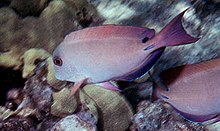Acanthurus nigrofuscus: Difference between revisions
Content deleted Content added
Cyberbot II (talk | contribs) Rescuing 1 sources. #IABot |
|||
| Line 16: | Line 16: | ||
}} |
}} |
||
'''''Acanthurus nigrofuscus''''', also known as the '''Lavender tang''', '''Brown Tang''', or '''Spot-Cheeked Surgeonfish''', is a [[Acanthuridae|tang]] from the [[Indo-Pacific]] and [[Hawaii]]. It commonly makes its way into the [[aquarium]] trade. It grows to 21 cm in length.<ref> |
'''''Acanthurus nigrofuscus''''', also known as the '''Lavender tang''', '''Brown Tang''', or '''Spot-Cheeked Surgeonfish''', is a [[Acanthuridae|tang]] from the [[Indo-Pacific]] and [[Hawaii]]. It commonly makes its way into the [[aquarium]] trade. It grows to 21 cm in length.<ref>{{cite web|url=http://www.fishbase.org/summary/4739 |title=Archived copy |accessdate=May 13, 2015 |deadurl=yes |archiveurl=http://web.archive.org/web/20150430042941/http://www.fishbase.org:80/summary/4739 |archivedate=April 30, 2015 }}</ref> Recently, a huge bacterium discovered in its intestine, ''[[Epulopiscium fishelsoni]]'',<ref name="Angert1993">{{cite journal |vauthors=Angert ER, Clements KD, Pace NR |title=The largest bacterium |journal=Nature |volume=362 |issue=6417 |pages=239–241 |pmid=8459849 |doi=10.1038/362239a0 |year=1993}}</ref><ref name="Angert1996">{{cite journal |vauthors=Angert ER, Brooks AE, Pace NR |title=Phylogenetic analysis of Metabacterium polyspora: Clues to the evolutionary origin of ''Epulopiscium'' spp., the largest bacteria |journal=Journal of Bacteriology |volume=178 |issue=5 |pages=1451–6 |year=1996 |pmid=8631724 |pmc=177821}}</ref> has been found to grow as large as 600 by 80 μm, a little smaller than a printed hyphen, which controls the pH of its host's gut, thereby influencing its host's ability to digest food and absorb nutrients. |
||
==Diet== |
==Diet== |
||
Revision as of 06:46, 27 May 2016
| Acanthurus nigrofuscus | |
|---|---|

| |
| Scientific classification | |
| Kingdom: | |
| Phylum: | |
| Class: | |
| Order: | |
| Family: | |
| Genus: | |
| Species: | A. nigrofuscus
|
| Binomial name | |
| Acanthurus nigrofuscus (Forsskål, 1775)
| |
Acanthurus nigrofuscus, also known as the Lavender tang, Brown Tang, or Spot-Cheeked Surgeonfish, is a tang from the Indo-Pacific and Hawaii. It commonly makes its way into the aquarium trade. It grows to 21 cm in length.[1] Recently, a huge bacterium discovered in its intestine, Epulopiscium fishelsoni,[2][3] has been found to grow as large as 600 by 80 μm, a little smaller than a printed hyphen, which controls the pH of its host's gut, thereby influencing its host's ability to digest food and absorb nutrients.
Diet
The Lavender Tang is an herbivore that grazes primarily on benthic algae. In captivity, they will also feed on animal matter such as brine shrimp and mysis shrimp.
References
- ^ "Archived copy". Archived from the original on April 30, 2015. Retrieved May 13, 2015.
{{cite web}}: Unknown parameter|deadurl=ignored (|url-status=suggested) (help)CS1 maint: archived copy as title (link) - ^ Angert ER, Clements KD, Pace NR (1993). "The largest bacterium". Nature. 362 (6417): 239–241. doi:10.1038/362239a0. PMID 8459849.
- ^ Angert ER, Brooks AE, Pace NR (1996). "Phylogenetic analysis of Metabacterium polyspora: Clues to the evolutionary origin of Epulopiscium spp., the largest bacteria". Journal of Bacteriology. 178 (5): 1451–6. PMC 177821. PMID 8631724.
- Froese, Rainer; Pauly, Daniel (eds.) (2008). "Acanthurus nigrofuscus" in FishBase. December 2008 version.

